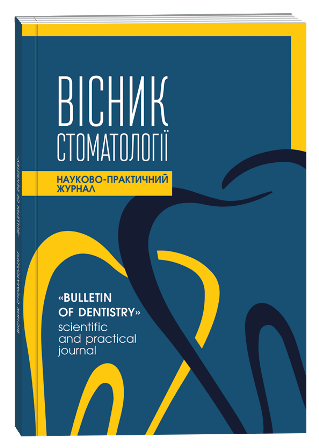EFFECT OF COVID-19 ON THE GENERAL CONDITION OF PATIENTS, SALIVARY GLANDS AND HARD DENTAL TISSUE
DOI:
https://doi.org/10.35220/2078-8916-2024-51-1.12Keywords:
covid-19, symptoms of disease in the oral cavity, caries, hyposalivation, acid resistance of enamel, correlation links.Abstract
The purpose of this study was to study the general health of patients with covid-19, as well as the state of the salivary glands and hard tissues of the teeth. Research materials and methods. The studies involved 12 people aged 27-51 years. All patients presented relevant documents about the past covid-19 disease, as well as certified certificates of their recovery. They studied as subjective indicators of the state of the oral cavity (disturbances of smell and taste), as well as all signs that indicate the presence of sialoadenitis. The presence of sialoadenitis could be evidenced by the following signs: hyposalivation, pain while eating and swallowing food; redness, swelling of the face or neck; disturbance of taste sensations; the presence of an unpleasant taste in the oral cavity; dry mouth; complexity in opening the mouth; the appearance of shortness of breath; general increase in body temperature. Objective parameters (condition of oral mucosa, salivation rate, enamel resistance) were also investigated. When evaluating the functional activity of the salivary glands, the salivation rate was assumed to be 0.5 to 1 ml/min. The acid resistance of the enamel was determined by a TEP test (enamel resistance test). Correlation analysis was performed using Pearson's method. Study results. It was found that almost all the studied symptoms were detected in patients of both groups, with the exception of facial edema, which was detected only in patients of group 2. Fever and dry cough were observed in all patients, both with mild and moderate disease. Patients of group 2 complained more about pain during meals, muscle pain and sore throat, the presence of fatigue. Headache, loss or disturbance of taste and smell were observed in everyone, but more often in persons with moderate COVID severity – 19. Taste disturbance, the presence of an unpleasant taste in the oral cavity was detected in patients of both groups, but more often in persons of the 2nd group. Dry mouth was detected in 100 % of patients in Group 2. Difficulty in opening the mouth was observed in patients with moderate disease severity. Almost all patients in Group 2 complained of shortness of breath and fever. In 5 patients out of 7 examined, sialadenitis was detected. In 9 people (64 %), the surface of the tongue was covered with a white-gray plaque, which very often indicates the presence of an infectious disease, including a viral one. Studies have shown that the rate of salivation in all patients was significantly lower than normal at all stages of the study. Patients with mild disease were found to have moderate acid resistance to enamel in most cases. There were no cases of very low acid resistance. A high correlation relationship between the rate of salivation and covid-19 disease was identified; the condition of oral hygiene was assessed as satisfactory.
References
Sharma Anshika, Ahmad Farouk Isra, & Lal Sunil Kumar. (2021). COVID-19: A Review on the Novel Coronavirus Disease Evolution, Transmission, Detection, Control and Prevention. Viruses, 13(2), 202-227. doi: 10.3390/ v13020202
Dhama Kuldeep, Khan Sharun, Tiwari Ruchi, Shubhankar & et al. (2020). Coronavirus Disease 2019– COVID-19. Clin Microbiol Rev., 33(4), 1-74 doi: 10.1128/ CMR.00028-20
Herrera, D., Serrano, J., Roldán, S., & Sanz, M. (2020). Is the oral cavity relevant in SARS-CoV-2 pandemic? Clin Oral Investig., 24(8), 2925-2930. doi: 10.1007/s00784-020-03413-2.
Drozdzik, A., & Drozdzik, M,. (2022). Oral Pathology in COVID-19 and SARS-CoV-2 Infection–Molecular Aspects. Int J Mol Sci. 23(3), 1431-1445 doi: 10.3390/ ijms23031431
Amante Luís Filipe Lima Sobral, Afonso João Torres Monteiro, & Skrupskelyte Greta. (2021). Dentistry and the COVID-19 Outbreak. Int Dent J., Oct; 71(5): Р. 358–368. doi: 10.1016/j.identj.2020.12.010
Huang, N., Pérez P., Kato, T., Mikami, Y., Okuda, K., Gilmore, R.C., Conde, C.D., Gasmi, B., Stein, S., Beach M., & et al. (2021). SARS-CoV-2 infection of the oral cavity and saliva. Nat. Med., 27, 892–903. doi: 10.1038/ s41591-021-01296-8
Pingping,Han, & Ivanovski Sašo (2020). Saliva‒ Friend and Foe in the COVID-19 Outbreak. Diagnostics (Basel), 10(5), 290-301. doi: 10.3390/diagnostics10050290
Barabari Poyan, N& ovel Keyvan Moharamzadeh. (2020). Coronavirus (COVID-19) and Dentistry–A Comprehensive Review of Literature. Dent J (Basel), 8(2), 53-71. doi: 10.3390/dj8020053
Online Calculator: Pearson Correlation Coefficient
Vergara, J, Lirani-Silva, C, Brodsky, M.B., Miles, A., Clavé, P., Nascimento, W., & Mourão, LF. (2021). Potential Influence of Olfactory, Gustatory, and Pharyngolaryngeal Sensory Dysfunctions on Swallowing Physiology in COVID-19. Otolaryngol Head Neck Surg., 164(6), 1134-1135. doi: 10.1177/0194599820972680.









